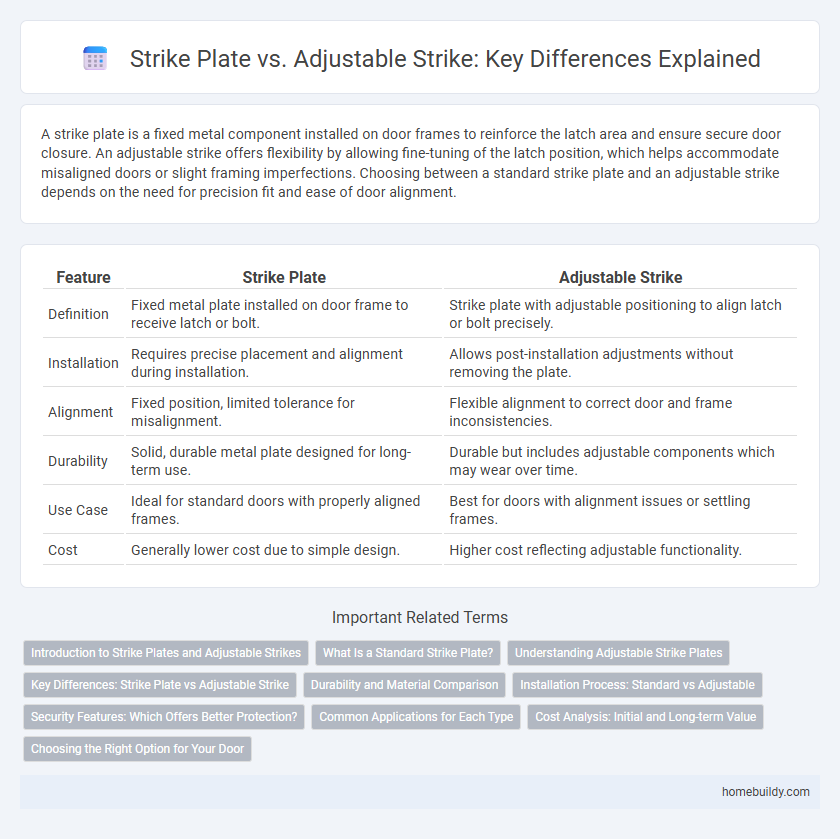A strike plate is a fixed metal component installed on door frames to reinforce the latch area and ensure secure door closure. An adjustable strike offers flexibility by allowing fine-tuning of the latch position, which helps accommodate misaligned doors or slight framing imperfections. Choosing between a standard strike plate and an adjustable strike depends on the need for precision fit and ease of door alignment.
Table of Comparison
| Feature | Strike Plate | Adjustable Strike |
|---|---|---|
| Definition | Fixed metal plate installed on door frame to receive latch or bolt. | Strike plate with adjustable positioning to align latch or bolt precisely. |
| Installation | Requires precise placement and alignment during installation. | Allows post-installation adjustments without removing the plate. |
| Alignment | Fixed position, limited tolerance for misalignment. | Flexible alignment to correct door and frame inconsistencies. |
| Durability | Solid, durable metal plate designed for long-term use. | Durable but includes adjustable components which may wear over time. |
| Use Case | Ideal for standard doors with properly aligned frames. | Best for doors with alignment issues or settling frames. |
| Cost | Generally lower cost due to simple design. | Higher cost reflecting adjustable functionality. |
Introduction to Strike Plates and Adjustable Strikes
Strike plates are metal components installed on door frames that reinforce latch engagement and ensure proper door closure. Adjustable strikes feature customizable positioning to accommodate varying door alignments and improve locking accuracy. Both serve critical roles in enhancing door security and operational functionality.
What Is a Standard Strike Plate?
A standard strike plate is a fixed metal plate installed on a door frame that reinforces the latch or bolt when the door is closed, ensuring secure engagement with the lock mechanism. Unlike adjustable strikes, which allow movement for precise alignment and enhanced door fit, a standard strike plate offers a simple, sturdy design best suited for doors with stable frames and consistent alignment. The choice between a standard strike plate and an adjustable strike depends on the door's environment and the need for flexibility in latch positioning.
Understanding Adjustable Strike Plates
Adjustable strike plates offer enhanced flexibility by allowing users to fine-tune the door alignment without removing or repositioning the entire plate, ensuring a precise fit and improved security. Unlike standard strike plates, which have fixed positions and may require labor-intensive adjustments if the door settles or shifts, adjustable strike plates enable quick compensation for frame movement or wear over time. This adaptability reduces maintenance efforts and prolongs the lifespan of locking mechanisms by maintaining optimal door latch engagement.
Key Differences: Strike Plate vs Adjustable Strike
A strike plate is a fixed metal plate mounted on a door frame, designed to receive the latch or bolt and enhance security by reinforcing the frame. An adjustable strike, however, allows for customizable positioning to accommodate misaligned doors or hardware, improving door closure and lock engagement. Key differences include fixed installation for strike plates versus flexibility and ease of adjustment offered by adjustable strikes, influencing both installation complexity and door alignment performance.
Durability and Material Comparison
Strike plates are typically made from stainless steel or brass, offering high durability and resistance to wear from standard door latch impact. Adjustable strikes often incorporate reinforced steel with additional plated coatings to enhance corrosion resistance and allow fine-tuning of latch alignment, improving functionality without compromising strength. When comparing materials, traditional strike plates provide robust longevity, while adjustable strikes balance durability with customizable fit for optimal door security.
Installation Process: Standard vs Adjustable
Standard strike plates require precise alignment during installation to ensure proper door latch engagement, often necessitating meticulous chiseling and screw placement. Adjustable strike plates simplify this process by offering movable components that allow fine-tuning after initial mounting, reducing installation time and improving fit accuracy. This flexibility makes adjustable strike plates particularly advantageous for doors with slight frame irregularities or shifting over time.
Security Features: Which Offers Better Protection?
Strike plates provide a fixed, sturdy reinforcement for door frames, enhancing security by distributing the force of a door impact over a wider area. Adjustable strike plates allow for precise alignment and improved door sealing, but their security depends on the quality of installation and materials used. Fixed strike plates made from hardened steel typically offer superior protection against forced entry compared to adjustable versions.
Common Applications for Each Type
Strike plates are commonly used in residential door installations to reinforce the latch area and ensure proper door alignment, providing security and durability for standard interior and exterior doors. Adjustable strikes are frequently utilized in commercial and high-traffic environments where door frames may settle over time or require fine-tuning for alignment, allowing maintenance flexibility without replacing the entire plate. Both types serve essential roles in enhancing door functionality, with adjustable strikes offering greater adaptability in variable conditions.
Cost Analysis: Initial and Long-term Value
Strike plates generally feature a lower initial cost compared to adjustable strike plates, making them a budget-friendly choice for standard door installations. Over time, adjustable strike plates offer improved long-term value by reducing maintenance expenses and accommodating door alignment changes without replacement. This adjustability minimizes repair costs and extends the lifespan of door hardware, providing cost efficiency beyond the initial investment.
Choosing the Right Option for Your Door
Strike plates provide a fixed, secure point for door latches, ensuring stability and consistent alignment, ideal for standard door frames. Adjustable strikes offer flexibility in positioning, allowing fine-tuning for doors that may settle or require precise latch alignment to prevent sticking or misalignment. Selecting between fixed strike plates and adjustable strikes depends on the door's condition, frame movement, and maintenance needs to guarantee optimal security and functionality.
Strike plate vs adjustable strike Infographic

 homebuildy.com
homebuildy.com